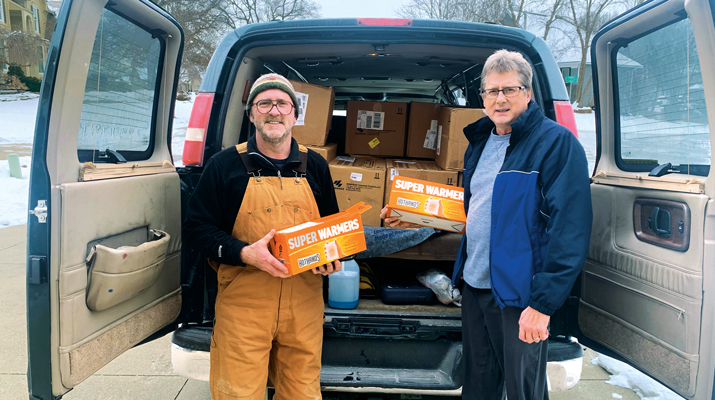Beyond the basics
An out-of-control vehicle swerving down a mountain road forces a propane delivery vehicle carrying 2,500 gallons of fuel into evasive action. It slides onto the icy shoulder, then plunges down a 40-foot embankment. Yet the load of propane stays intact.
The scenario unfolded earlier this year for Dependable Energy Services of Ulster, N.Y.
“It rolled over at least twice, and there was no leaking. The canopy took a direct hit from a tree while it was rolling over,” recounts Dave Waugh, fleet and safety manager for Paraco Gas Corp., Dependable’s parent firm.
The driver was bruised from bouncing around the cab, but Waugh credits the design of the the truck – known as the Clipper – for averting an explosion.
The main propane line is protected deep within the Clipper’s tank assembly. A canopy extends out over the rear of the truck, shielding the valve apparatus from both the elements and damage during rollovers. The truck also has a notched bumper design that allows the driver to work while out of harm’s way from a rear-end collision.
The Clipper is a creation of Amthor International Inc., a fourth-generation family manufacturer based in Gretna, Va. The company’s unique design features are gaining acceptance among propane marketers impressed with the vehicle’s safety and productivity innovations.
“It is safety-plus,” declares Al Stillwaggon, president of Weaver Gas, which serves a four-county area around Newburgh, N.Y. Stillwaggon also is a member of the National Propane Gas Association’s Education and Technology & Standards committees, as well as a local firefighter.
His company owns five Clippers, and to Stillwaggon the redesigned Clipper is the only way to go.
“I don’t know why the rest of the industry isn’t doing it,” he says.
“I’d definitely recommend these to anyone,” agrees Doug Allen, dispatcher for Allen’s Oil and Propane of Vincentown, N.J. The company just bought its second Clipper to fill out its nine-truck fleet.
“For every new truck we get I’d like to push for the Clipper,” Allen reports.
He says the back canopy effectively protects exposed apparatus on bobtails from short circuits and other equipment malfunctions in harsh weather conditions.
 A protective canopy shield instruments from bad weather while the extended bumper protects drivers from approaching traffic. |
“It has a much cleaner look, and all the controls are covered. It’s much better than the old setup,” adds Allen, whose father, Ron, was initially reluctant to buy the truck when they first appeared at a trade show.
A covered, inverted hose reel is another popular feature. Instead of tugging and dragging the hose outward, a Clipper driver pulls downward on it much like the ceiling-mounted grease guns at automobile service centers.
“The driver can do more stops with the Clipper hose reel,” notes Stillwaggon. “The hose will follow him (or her) several feet before it hits the ground,” and the hose is less likely to get torn by fencing and other hazards.
A remote push-button rewinding capability is another labor-saver.
“It makes it so much easier because the driver doesn’t get exhausted and the hose lasts much longer. And the hose reel doesn’t get slopped-up with ice and snow,” he says.
At New York-based Paraco, 19 of of the company’s 40 trucks are Clippers.
“We bought our first Clipper in 2000. In 2001 I bought seven more,” says Waugh. “Only one driver wanted to go back to a bobtail after that.”
Hot product
“This product has been taking the industry by storm,” says Brain Amthor, company marketing manager. “Anyone who has bought one hasn’t gone back to a bobtail.”
About 150 are currently in use.
In 1992 Amthor opened its 42,000-square-foot plant in Gretna to produce its lines of propane vehicles, fuel oil delivery units, fire tankers and water trucks. A 10,000-square-foot addition was built in 1998 to house its newly revamped propane tanker line.
The Clipper was conceived eight years ago during “a cup of coffee and three hours of discussion on a Saturday afternoon,” Amthor recalled. The canopy idea came from the design of fuel oil trucks with other engineering enhancements coming from field-based propane experience.
The safety of the notched bumper assembly was tragically illustrated when a bobtail driver was killed in a rear-end collision in New Jersey, his legs severed from his body by the impact.
“On a bobtail, the driver has his (or her) back toward traffic. On a Clipper, the car will hit the bumper before it hits the driver,” Amthor says.
Widespread injuries to the backs of bobtail drivers prompted the inverted hose reel, a development that has gained the admiration of unions and insurance carriers, according to Amthor.
“On a bobtail you’re pulling the hose straight out. On the Clipper, the driver is pulling the hose out at an angle, which requires less exertion,” he explains.
A Clipper costs $400 to $600 more than a bobtail, Amthor says.
“When I price trucks, the Clippers are very competitive. My CEO wouldn’t let me buy any trucks if I couldn’t get a good buy,” observes Waugh at Paraco. “We’re very pleased with the Clipper so far.”
For more information, call 845-778-5576 or visit www.amthorinternational.com.
















